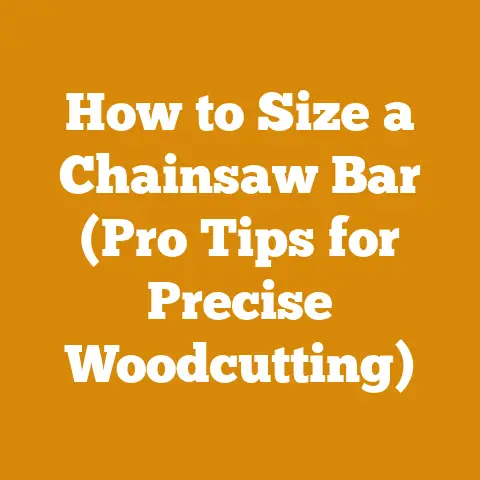When to Prune Dogwood Trees (5 Pro Tips for Perfect Cuts)
The first glimpse of a dogwood in full bloom is a sight that stops you in your tracks. Those elegant bracts, often mistaken for petals, herald the arrival of spring with unmatched grace. But maintaining that beauty, and ensuring the long-term health of your dogwood, requires proper pruning. And that’s where things can get a little tricky. When is the right time to prune? How do you avoid damaging these delicate trees? In this article, I’ll share five pro tips, gleaned from years of experience working with dogwoods, to help you make perfect cuts and keep your trees thriving.
I remember the first time I was tasked with pruning a large, mature dogwood. I was nervous! These trees are notoriously sensitive, and one wrong cut can lead to disease or unsightly growth. But with careful planning, the right tools, and a solid understanding of dogwood biology, I learned to prune with confidence. And now, I want to share that knowledge with you.
Understanding Dogwood Pruning: More Than Just Aesthetics
Before we dive into the “when” and “how,” it’s crucial to understand why we prune dogwoods. Pruning isn’t just about making the tree look pretty (although that’s certainly a benefit!). It’s about:
- Promoting Air Circulation: Dogwoods are susceptible to fungal diseases like anthracnose and powdery mildew. Opening up the canopy allows for better air circulation, reducing humidity and minimizing the risk of infection.
- Removing Dead, Diseased, or Damaged Branches: These branches are not only unsightly but can also harbor pests and diseases that can spread to the rest of the tree.
- Improving the Tree’s Structure: Pruning can help shape the tree, encourage strong branch growth, and prevent branches from crossing or rubbing against each other.
- Encouraging Flowering: While dogwoods naturally bloom profusely, proper pruning can help maximize flower production in subsequent years.
- Maintaining Size and Shape: Pruning can help keep your dogwood within a manageable size, especially if it’s planted in a smaller garden.
Tip #1: Timing is Everything – The Best Time to Prune Dogwoods
The absolute best time to prune dogwood trees is late winter or early spring, just before new growth begins. This typically falls between February and April in most temperate climates. Here’s why this timing is ideal:
- Dormancy: The tree is dormant, meaning it’s not actively growing. This minimizes stress on the tree and reduces the risk of disease transmission.
- Visibility: Without leaves, you have a clear view of the tree’s structure, making it easier to identify dead, damaged, or crossing branches.
- Wound Closure: As the tree begins to grow in the spring, it will quickly seal pruning wounds, preventing infection and decay.
Why not other times of the year?
- Summer Pruning: While you can prune lightly in the summer to remove water sprouts or suckers, avoid major pruning. The tree is actively growing and more susceptible to stress.
- Fall Pruning: Fall pruning is generally discouraged. As the tree prepares for winter, it’s less able to seal wounds, increasing the risk of fungal infections.
My Personal Experience: I once pruned a dogwood in the late fall, thinking I was getting a head start on spring. Big mistake! The following spring, the tree was riddled with fungal problems, and it took years to recover. I learned my lesson: stick to late winter or early spring pruning for the best results.
Tip #2: Essential Tools for Dogwood Pruning – Investing in Quality
Having the right tools is crucial for making clean, precise cuts that promote healing. Here’s what you’ll need:
- Hand Pruners: For small branches (up to ¾ inch in diameter). Look for bypass pruners, which make cleaner cuts than anvil pruners.
- Loppers: For larger branches (up to 2 inches in diameter). Loppers provide more leverage and allow you to reach higher branches.
- Pruning Saw: For branches larger than 2 inches in diameter. A folding pruning saw is lightweight and easy to carry.
- Pole Pruner: For reaching high branches without using a ladder.
- Gloves: To protect your hands from thorns and scratches.
- Eye Protection: To protect your eyes from flying debris.
- Disinfectant: To clean your tools between cuts and prevent the spread of disease. I use a solution of 1 part bleach to 9 parts water.
Cost Breakdown for Pruning Tools:
| Tool | Average Cost (USD) | Lifespan (Years) | Notes |
|---|---|---|---|
| Hand Pruners | $30 – $60 | 5-10 | Felco, Corona, and ARS are reputable brands. |
| Loppers | $40 – $80 | 5-10 | Consider loppers with telescoping handles for added reach. |
| Pruning Saw | $25 – $50 | 3-7 | Look for saws with impulse-hardened teeth for longer sharpness. |
| Pole Pruner | $50 – $150 | 5-10 | Choose a lightweight pole pruner with a bypass cutting head. |
| Gloves | $10 – $20 | 1-2 | Leather gloves offer the best protection. |
| Eye Protection | $5 – $15 | Indefinite | Safety glasses or goggles are essential. |
| Disinfectant | $5 – $10 | 1-2 | Bleach or rubbing alcohol can be used as a disinfectant. |
Tool Maintenance is Key:
- Sharpening: Keep your pruning tools sharp to make clean cuts. Use a sharpening stone or file to maintain the cutting edge. I usually sharpen my pruners and loppers at least once a year, sometimes more often if I’m doing a lot of pruning.
- Cleaning: Clean your tools after each use to remove sap and debris. This will help prevent the spread of disease.
- Oiling: Oil your tools regularly to prevent rust and keep them working smoothly. A light coating of machine oil or WD-40 will do the trick.
My Budgeting Tip: Instead of buying the cheapest tools, invest in high-quality pruners and loppers. They’ll last longer, make cleaner cuts, and ultimately save you money in the long run. I’ve been using my Felco pruners for over 10 years, and they’re still going strong.
Tip #3: The Art of the Cut – Making Precise and Effective Pruning Cuts
Knowing where to cut is just as important as knowing when to cut. Here are some guidelines for making precise and effective pruning cuts on dogwood trees:
- Cut at the Branch Collar: The branch collar is the slightly swollen area where a branch joins the trunk. Make your cut just outside the branch collar, leaving a small stub (about ¼ inch). This allows the tree to heal properly.
- Avoid Flush Cuts: Flush cuts, where you cut the branch completely flush with the trunk, can damage the tree’s vascular system and prevent healing.
- Angle Your Cuts: When pruning branches that are growing outward, angle your cut slightly upward. This will encourage new growth to grow in the same direction.
- Make Clean Cuts: Use sharp tools to make clean, precise cuts. Ragged or torn cuts can invite pests and diseases.
- Prune for Shape: When pruning for shape, visualize the desired form of the tree and make cuts accordingly. Remove branches that are growing in the wrong direction or that are crowding the canopy.
- Remove Water Sprouts and Suckers: Water sprouts are vigorous, upright shoots that grow from the trunk or branches. Suckers are shoots that grow from the base of the tree. Remove these as they appear, as they can sap energy from the tree.
Specific Pruning Scenarios:
- Dead Branches: Remove dead branches completely, cutting back to healthy wood.
- Diseased Branches: Remove diseased branches as soon as possible to prevent the spread of infection. Disinfect your tools after each cut.
- Crossing Branches: Remove one of the crossing branches to prevent them from rubbing against each other and creating wounds.
- Rubbing Branches: Remove one of the rubbing branches to prevent bark damage.
- Weak or Thin Branches: Remove weak or thin branches to encourage stronger growth.
The 1/3 Rule: As a general guideline, avoid removing more than one-third of the tree’s canopy in a single pruning session. This can stress the tree and make it more susceptible to disease.
Visual Aid: I find it helpful to take a step back and look at the tree from different angles before making any cuts. This helps me visualize the overall shape and identify branches that need to be removed.
Tip #4: Addressing Common Dogwood Problems Through Pruning
Dogwoods are susceptible to several common problems, and pruning can play a crucial role in managing these issues:
- Dogwood Anthracnose: This fungal disease causes leaf spots, twig dieback, and can eventually kill the tree. Prune out infected branches to improve air circulation and slow the spread of the disease. Dispose of infected branches properly (burn them or bag them and send them to the landfill).
- Powdery Mildew: This fungal disease causes a white, powdery coating on the leaves. Prune to improve air circulation and reduce humidity.
- Borers: Dogwood borers are insects that tunnel into the tree’s trunk and branches. Prune out infested branches and keep the tree healthy to prevent future infestations.
- Canker Diseases: Canker diseases cause sunken, dead areas on the bark. Prune out infected branches and promote overall tree health.
Preventative Pruning:
- Thin the Canopy: Thinning the canopy allows for better air circulation, reducing humidity and minimizing the risk of fungal diseases.
- Remove Deadwood: Removing deadwood eliminates potential breeding grounds for pests and diseases.
- Maintain Vigor: Keeping the tree healthy and vigorous will make it more resistant to pests and diseases.
Cost of Disease Treatment:
If pruning alone isn’t enough to control disease, you may need to consider chemical treatments. Here’s a rough estimate of the costs involved:
| Treatment | Average Cost (USD) | Frequency | Notes |
|---|---|---|---|
| Fungicide Application | $50 – $200 per tree | 2-4 times per year | Cost depends on the size of the tree and the type of fungicide used. |
| Insecticide Application | $50 – $200 per tree | 2-4 times per year | Cost depends on the size of the tree and the type of insecticide used. |
My Recommendation: Before resorting to chemical treatments, try to improve the tree’s health through proper pruning, watering, and fertilization. Often, these measures are enough to control minor infestations or diseases.
Tip #5: Aftercare – Promoting Healing and Growth After Pruning
Pruning can be stressful for a tree, so it’s important to provide proper aftercare to promote healing and growth:
- Watering: Water the tree deeply after pruning, especially during dry periods.
- Fertilizing: Fertilize the tree in the spring with a balanced fertilizer to provide essential nutrients. I usually use a slow-release fertilizer specifically formulated for trees and shrubs.
- Mulching: Apply a layer of mulch around the base of the tree to help retain moisture, suppress weeds, and regulate soil temperature. Keep the mulch a few inches away from the trunk to prevent rot.
- Wound Dressing: While not always necessary, you can apply a wound dressing to large pruning cuts to protect them from pests and diseases. However, some experts believe that wound dressings can actually hinder healing, so use them sparingly.
- Monitor for Pests and Diseases: Keep an eye on the tree for signs of pests or diseases and take action as needed.
Long-Term Care:
- Regular Pruning: Prune the tree annually to maintain its shape and health.
- Soil Testing: Test the soil every few years to determine if it needs any amendments.
- Professional Help: If you’re unsure about pruning your dogwood, consult with a certified arborist.
Cost of Aftercare:
| Item | Average Cost (USD) | Frequency | Notes |
|---|---|---|---|
| Fertilizer | $20 – $50 per bag | Annually | Choose a fertilizer specifically formulated for trees. |
| Mulch | $30 – $50 per yard | Annually | Use organic mulch, such as wood chips or shredded bark. |
| Soil Testing | $20 – $50 per test | Every 3-5 years | Contact your local extension office for soil testing services. |
| Arborist Consultation | $50 – $150 per hour | As needed | A certified arborist can provide expert advice and services. |
My Final Thought: Pruning dogwood trees can seem daunting at first, but with a little knowledge and practice, you can keep your trees healthy, beautiful, and thriving for years to come. Remember to take your time, use sharp tools, and make clean cuts. And don’t be afraid to ask for help if you need it.
Actionable Takeaways:
- Prune in late winter or early spring (February-April).
- Invest in quality pruning tools and keep them sharp.
- Make precise cuts at the branch collar.
- Address common dogwood problems through pruning.
- Provide proper aftercare to promote healing and growth.
By following these five pro tips, you’ll be well on your way to mastering the art of dogwood pruning and enjoying the beauty of these magnificent trees for many years to come. Happy pruning!






